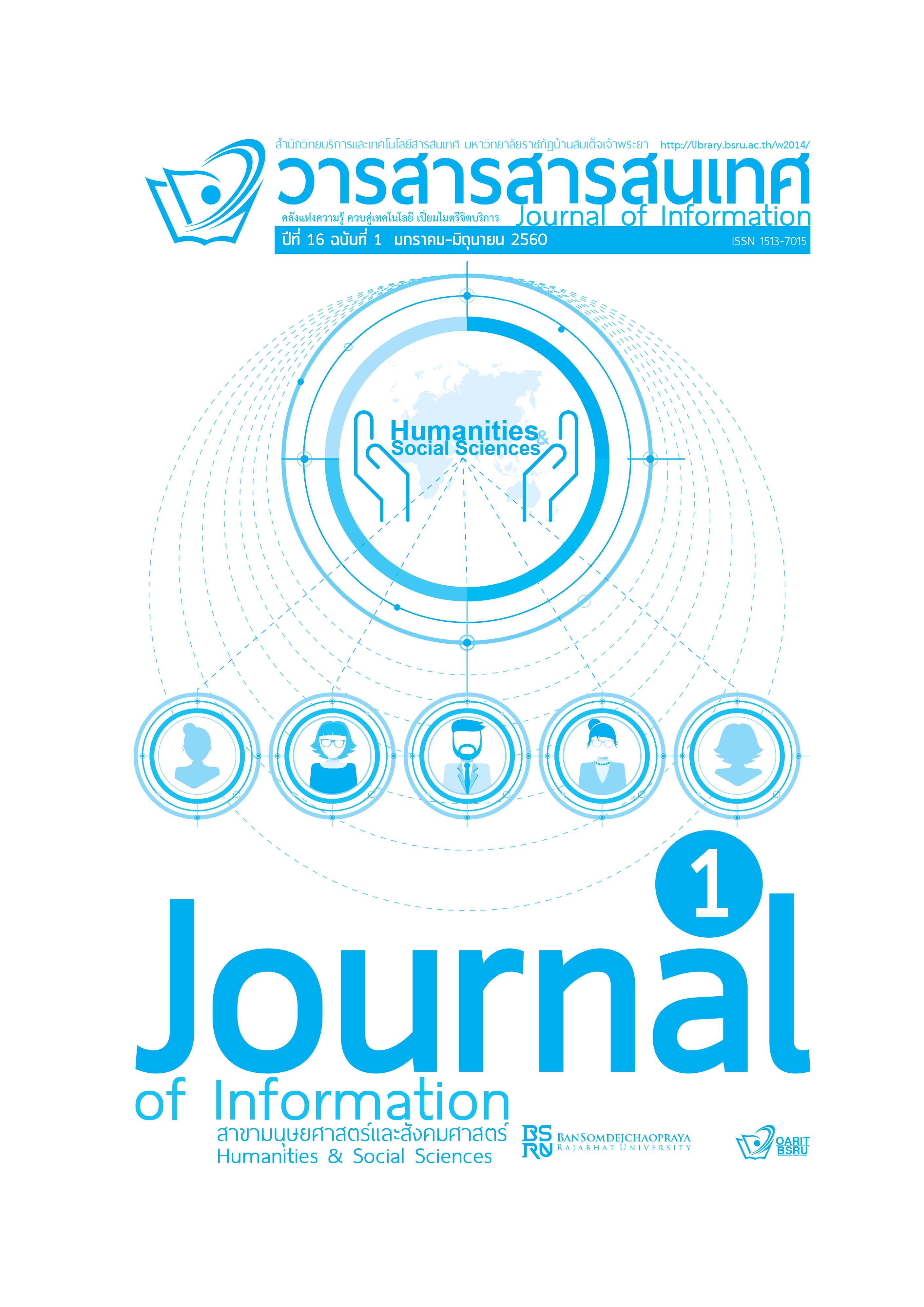การสังเคราะห์งานวิจัยที่เกี่ยวข้องกับการประกันคุณภาพการศึกษา ด้วยเทคนิคการวิเคราะห์เนื้อหาและการวิเคราะห์อภิมาน : The Synthesis of Research Results on EducationQualityAssurance by Content and Meta Analysis Techniques
Keywords:
การสังเคราะห์งานวิจัย, การประกันคุณภาพการศึกษา, การวิเคราะห์เนื้อหา, research synthesis, education quality assurance, content analysisAbstract
บทคัดย่อ
การวิจัยครั้งนี้มีวัตถุประสงค์เพื่อสังเคราะห์งานวิจัยที่เกี่ยวข้องกับการประกันคุณภาพการศึกษาด้วยเทคนิคการวิเคราะห์เนื้อหา และเทคนิคการวิเคราะห์อภิมานกลุ่มตัวอย่างที่ใช้เป็นวิทยานิพนธ์ของนักศึกษาระดับบัณฑิตศึกษา พิมพ์เผยแพร่ระหว่างปีการศึกษา 2547-2557 งานวิจัยที่นำมาสังเคราะห์ด้วยเทคนิคการวิเคราะห์เนื้อหา จำนวน 110 เรื่อง ส่วนงานที่นำมาสังเคราะห์ด้วยเทคนิคการวิเคราะห์อภิมานมีจำนวน 39 เรื่อง เครื่องมือที่ใช้ในการวิจัย มีดังนี้ แบบบันทึกข้อมูลคุณลักษณะของงานวิจัย แบบบันทึกรายละเอียดของงานวิจัย และแบบประเมินคุณภาพงานวิจัย การวิเคราะห์ข้อมูลเบื้องต้นใช้สถิติพื้นฐาน ได้แก่ ความถี่ร้อยละและการบรรยายสรุปผลการวิจัยและข้อเสนอแนะของงานวิจัยการวิเคราะห์อภิมานใช้แนวคิดของกลาส(Glass) ในการหาค่าขนาดอิทธิพล การประเมินคุณภาพงานวิจัยใช้มาตราส่วนประมาณค่า 5 ระดับ ของลิเคิร์ท(Likert) การตรวจสอบคุณภาพเครื่องมือโดยวิธี (IOC) วิเคราะห์ข้อมูลโดยสถิติบรรยายและใช้โปรแกรมคอมพิวเตอร์
ผลการวิจัยพบว่า ผลการประเมินคุณภาพของงานวิจัยในภาพรวมอยู่ในระดับดีมาก( =3.809)เมื่อเปรียบเทียบตามเพศพบว่านักวิจัยเพศหญิงทำงานวิจัยที่มีคุณภาพสูงกว่าเพศชายผลการวิเคราะห์เนื้อหาพบผลการวิจัยดังนี้ สถาบันที่ศึกษา มีความเกี่ยวข้องกับการประกันคุณภาพภายในสถานศึกษามากที่สุด คือ มหาวิทยาลัยราชภัฏ ปีการศึกษาที่ผลิตงานวิจัยมากที่สุด คือ ปีการศึกษา 2547-2550 ประเภทงานวิจัยที่พบมากที่สุด คือ การวิจัยเชิงสำรวจ โดยการสุ่มกลุ่มตัวอย่างแบบแบ่งชั้นถูกนำมาใช้มากที่สุดกลุ่มตัวอย่างที่พบมากที่สุดเป็นผู้บริหารสถานศึกษาเครื่องมือที่ใช้ในการวิจัย พบว่ามีการใช้แบบสอบถามเป็นเครื่องมือในการวิจัยมากที่สุด สถิติพื้นฐานที่ใช้วิเคราะห์ข้อมูลมากที่สุด คือ ความถี่ ร้อยละ ค่าเฉลี่ย ส่วนเบี่ยงเบนมาตรฐาน และสถิติทดสอบสมมติฐาน t-test และ F-test ผลสรุปซึ่งได้จากผลการวิจัยพบว่า งานวิจัยส่วนใหญ่ศึกษาการดำเนินงานประกันคุณภาพการศึกษาของผู้บริหารสถานศึกษาและครู โดยพบการดำเนินงานการประกันคุณภาพอยู่ในระดับมาก รองลงมาเป็นการศึกษาความพร้อมในการประกันคุณภาพ ผลการวิจัยส่วนใหญ่แสดงระดับความพร้อมอยู่ในระดับมากทั้งผู้บริหารและครู กับการศึกษาสภาพและปัญหาการดำเนินงานการประกันคุณภาพ โดยพบสภาพปัญหาในระดับปานกลาง เมื่อจำแนกตัวแปร ตามตำแหน่ง ผลการดำเนินงานการประกันคุณภาพไม่แตกต่างกัน แต่เมื่อจำแนกตามขนาดโรงเรียนมีผลการวิจัยทั้งที่สอดคล้องและไม่สอดคล้องกัน โดยงานวิจัยส่วนใหญ่พบว่า ผู้บริหารและครูในโรงเรียนขนาดต่างกัน มีความคิดเห็นที่แตกต่างกัน 2) ผลการวิเคราะห์อภิมาน จำแนก ตามตัวแปรขนาดโรงเรียนและตัวแปรตำแหน่ง มีค่าเฉลี่ยขนาดอิทธิพล เท่ากับ 0.199 โดยพบค่าความแปรปรวนของตำแหน่งและขนาดโรงเรียนมีค่าเท่ากับ 0.048 และ 0.049 ตามลำดับผลการวิเคราะห์อภิมาน พบว่า ปัจจัยที่สัมพันธ์กับการประกันคุณภาพการศึกษา ปัจจัยด้านการบริหาร มีค่าขนาดอิทธิพลเฉลี่ยสูงสุด รองลงมาคือปัจจัยด้านมาตรฐานและปัจจัยด้านข้อมูลตามลำดับปัจจัยด้านการบริหาร ขนาดของโรงเรียน มีค่าขนาดอิทธิพลเฉลี่ยสูงที่สุด รองลงมา คือผู้บริหารและครู เพศ และประสบการณ์ทำงานตามลำดับ ปัจจัยด้านมาตรฐาน มาตรฐานด้านปัจจัย มีค่าขนาดอิทธิพลเฉลี่ยสูงที่สุด รองลงมา คือมาตรฐานด้านกระบวนการ มาตรฐานด้านครู และมาตรฐานด้านผู้บริหารปัจจัยด้านข้อมูล การตรวจสอบข้อมูลมีค่าขนาดอิทธิพลเฉลี่ยสูงที่สุด รองลงมา คือ การประมวลผลข้อมูล การนำเสนอข้อมูล การเก็บรวบรวมข้อมูลและการจัดเก็บข้อมูลตามลำดับ
Abstract
The objectives of this research were: to synthesize research results on education quality assurance using content analysis and meta analysis techniques. These researches were completed between A.D. 2004-2014. The content analysis was for fundamental data summarizing research result summary and recommendation summary of 110 internal education assurance research reports. The meta analysis of 39 education quality assurance research reports used comparative and correlation techniques, demonstrating relational model among variables related to education quality assurance. The samples were graduate students thesisespublished between education year 2004-2014. The statistics for fundamental data analysis were frequency, percentage and summarization of research results and recommendations. Glass’s methods on meta analysis were used to calculate the effect size. The evaluation of research quality used Likert 5-Scale rating technique. The instrument quality was verified by Item Objective Congruence (IOC) method. Descriptive data analysis and computer program were also used.
The research results revealed that the evaluation of research quality as a whole was at very high level. Comparing the research quality between gender found that female was higher than male. The content analysis revealed that the Rajabhat Institutes concerned with education quality assurance the most. During education year 2004-2014 they produced research works the most. The survey researches were out number and stratified random sampling technique were also out number the other types. The frequently used samples were school administrators and instruments were questionnaires. The statistics for fundamental data analysis were frequency, mean, percentage and standard deviation and hypothesises were tested by t-test and F-test. The summarizing of research results found that most of the research works dealt with education quality assurance of school administrators and teachers. The education quality assurance researches were at the high level, next were the readiness for education quality assurance works. Most of them revealed high level of readiness for both administrators and teachers. On state and problem of education quality assurance found that the problems were at moderate level. When considered status variables. the results of education quality assurance were not different. When classified by school sizes found both consistent and inconsistent results. Most of the research results found that the school administrators and teachers of different school sizes opined differently. 2) Meta analysis classified by school sizes and positions found effect size at 0.199 and position variance and school size variance were at 0.048 and 0.049 respectively. The factors (variables) related to education quality assurance were administrative variables with the highest effect size and next variables were standard variable and data variable respectively. On administrative variable, school size had the highest effect size and next variables, were administrators and teachers, gender, and works experience variable respectively. On standard variable, criteria variable had the highest effect size and next variables were process standard, teacher standard and administrator variables respectively. On data variable, data verification variable had the highest effect size, followed by data processing, data presentation, data collection and data storage variables respectively.
Downloads
Published
How to Cite
Issue
Section
License
บทความ ข้อความ ภาพประกอบ และตารางประกอบที่ลงพิมพ์ในวารสารเป็นความคิดเห็นส่วนตัวของผู้นิพนธ์ กองบรรณาธิการไม่จำเป็นต้องเห็นตามเสมอไป และไม่มีส่วนรับผิดชอบใดๆ ถือเป็นความรับผิดชอบของผู้นิพนธ์เพียงผู้เดียว






